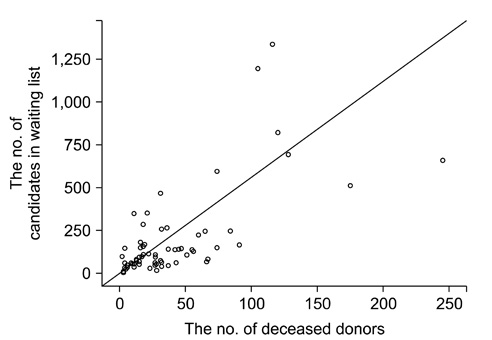J Korean Soc Transplant.
2017 Sep;31(3):143-149. 10.4285/jkstn.2017.31.3.143.
Current System for Allocation of Deceased Donor Kidney Transplantation
- Affiliations
-
- 1Department of Surgery, Ajou University Hospital, Ajou University School of Medicine, Suwon, Korea. bjb425@gmail.com
- 2Network for Organ Transplantation, Seoul, Korea.
- KMID: 2392421
- DOI: http://doi.org/10.4285/jkstn.2017.31.3.143
Abstract
- BACKGROUND
This study was conducted to analyze the current system for allocation of deceased donor kidney transplantation in Korea, which includes an incentive regulation for candidates registered at the Hospital-based Organ Procurement Organization (HOPO).
METHODS
Between January 2011 and November 2016, there were 2,655 deceased donors in Korea. During the same period, there were 21,247 current candidates and recipients of kidney, pancreas and simultaneous pancreas-kidney transplants. We analyzed data from all of these donors, candidates, and recipients.
RESULTS
Mean waiting times for organ allocation of each priority differed significantly (2nd priority group, 1,701±974 days; 3rd priority group, 1,316±927 days; 4th priority group, 2,077±1,207 days). Additionally, HOPO candidates/deceased donor ratios were very different from each other (maximum, 49; minimum, 0.6). The number of deceased donors in region 1, 2, and 3 were 1,623, 429, and 603, respectively, while the number of transplantations in each region was 3,095, 597, and 1,165, respectively. The candidates registered at region 1 HOPO moved the longest distances on average for transplantation, and this value differed significantly different from that of other regions (56.18±91.9 km vs. 24.66±28.0 km vs. 26.20±37.3 km, P<0.05).
CONCLUSIONS
The incentive system of current allocation system for deceased donor kidney in Korea does not coincide with the purpose of the "˜Declaration of Istanbul' and unnecessary social costs have occurred. Therefore, we should make an effort to change our current allocation system to the geographic sequence of organ allocation system.
MeSH Terms
Figure
Reference
-
1. Min SI, Ahn SH, Cho WH, Ahn C, Kim SI, Ha J. Optimal system for deceased organ donation and procurement in Korea. J Korean Soc Transplant. 2011; 25:1–7.
Article2. Korean Network for Organ Sharing (KONOS). Annual data report [Internet]. Seoul: KONOS;c2014. cited 2017 Aug 24. Available from: https://www.konos.go.kr/konosis/common/bizlogic.jsp.3. Steering Committee of the Istanbul Summit. Organ trafficking and transplant tourism and commercialism: the Declaration of Istanbul. Lancet. 2008; 372:5–6.4. Kim MG, Jeong JC, Cho EJ, Huh KH, Yang J, Byeon NI, et al. Operational and regulatory system requirements for pursuing self-sufficiency in deceased donor organ transplantation program in Korea. J Korean Soc Transplant. 2010; 24:147–158.
Article5. United Network for Organ Sharing (UNOS). OPTN/SRTR annual report [Internet]. Richmond: UNOS;c2015. cited 2017 Aug 24. Available from: http://www.unos.org.6. Statistics Korea. Regional population and population density [Internet]. Daejeon: Statistics Korea;c1996. cited 2017 Aug 24. Available from: http://www.index.go.kr/potal/main/EachDtlPageDetail.do?idx_cd=1007.7. Lee JM, Lee YJ, Kyung KD, Im YC, Oh CK, Ahn JH, et al. Clinical analysis of 10 years brain death donors in single center after Korean Network for Organ Sharing. J Korean Soc Transplant. 2010; 24:196–203.
Article8. Lee SH, Huh KH, Lee HS, Kim HJ, Kim MS, Joo DJ, et al. Waiting time for deceased donor kidney allocation in Korea: a single center experience. J Korean Soc Transplant. 2012; 26:32–37.
Article9. Eurotransplant International Foundation. Eurotransplant manual version 3.0 [Internet]. Leiden: Eurotransplant International Foundation;2013. cited 2017 Aug 24. Available from: http://www.eurotransplant.org/cms/mediaobject.php?file=Chapter4_thekidney7.pdf.
- Full Text Links
- Actions
-
Cited
- CITED
-
- Close
- Share
- Similar articles
-
- Current Status of Deceased Donor Organ Recovery and Sharing in Korea
- Evaluation and Utilization of Expanded Criteria Dornor
- Waiting Time for Deceased Donor Kidney Allocation in Korea: A Single Center Experience
- Current Status of Deceased Donor Liver Transplantation for Alcoholic Liver Disease in Korea in MELD Era
- Status and Current Problems in the Allocation System for Pediatric Liver Transplantation in Korea


